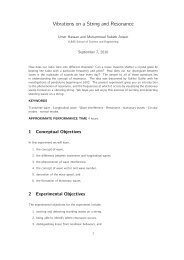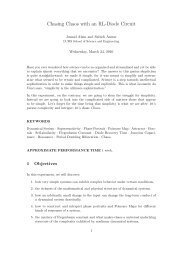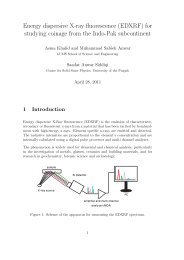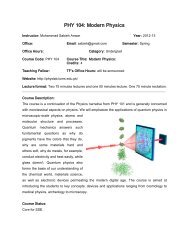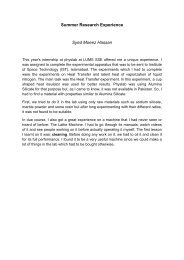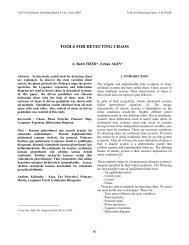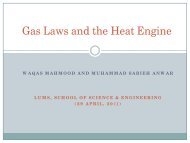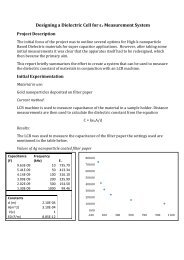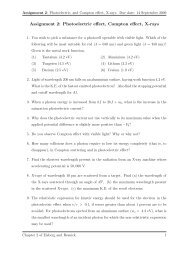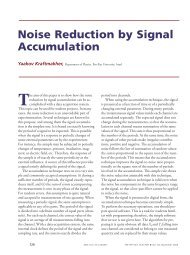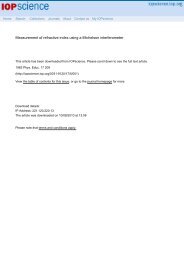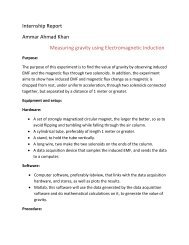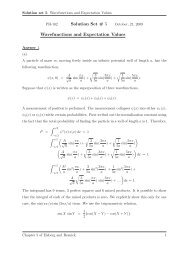SUPEROPERATORS IN NMR 1. Introduction to State and Hilbert ...
SUPEROPERATORS IN NMR 1. Introduction to State and Hilbert ...
SUPEROPERATORS IN NMR 1. Introduction to State and Hilbert ...
Create successful ePaper yourself
Turn your PDF publications into a flip-book with our unique Google optimized e-Paper software.
<strong>SUPEROPERATORS</strong> <strong>IN</strong> <strong>NMR</strong><br />
A SUMMARY<br />
MUHAMMAD SABIEH ANWAR<br />
<strong>1.</strong> <strong>Introduction</strong> <strong>to</strong> <strong>State</strong> <strong>and</strong> <strong>Hilbert</strong> Spaces<br />
Consider an <strong>NMR</strong> system of N spins, each spin with I = 1/2. Corresponding<br />
<strong>to</strong> this system, there will be a function or state space Fn of<br />
dimension n = 2 N . <strong>State</strong>s of the system are represented as kets or functions<br />
|ψ〉 belonging <strong>to</strong> Fn. However, for the case of nuclear spins, these functions<br />
happen <strong>to</strong> be only a mathematical abstraction. Strictly, Fn is spanned by a<br />
continuous basis. Unfortunately, in the present scenario of nuclear spins we<br />
are dealing with, no such basis exists <strong>and</strong> we have <strong>to</strong> look for alternative,<br />
discrete bases. So the kets are mapped in<strong>to</strong> an n-dimensional <strong>Hilbert</strong> space<br />
which is a linear vec<strong>to</strong>r space. Again we assume our <strong>Hilbert</strong> space <strong>to</strong> be<br />
finite <strong>and</strong> discrete. The mapping is from Fn <strong>to</strong> Hn. In (1), the ↦−→ has been<br />
used in place of equality <strong>to</strong> signify this transformation.<br />
|ψ〉 ↦−→<br />
⎡<br />
n<br />
ci|i〉<br />
i=1<br />
c1<br />
⎢<br />
⎢c2<br />
⎥<br />
⎢<br />
= ⎢c3<br />
⎥<br />
⎢ ⎥<br />
⎣ . ⎦<br />
The coefficients ci in (1) are the components of the n-dimensional<br />
vec<strong>to</strong>r <strong>and</strong> are given as:<br />
cn<br />
⎤<br />
<br />
n<br />
<br />
ci = 〈i| cj|j〉<br />
j=1<br />
The set of vec<strong>to</strong>rs, n = {|j〉, j = 1, 2, . . . , n} forms a discrete, orthonormal<br />
basis, in the <strong>Hilbert</strong> space Hn, simultaneously satisfying the two<br />
conditions given in (3).<br />
(1)<br />
(2)<br />
〈i|j〉 = δij (3a)<br />
n<br />
|i〉〈i| = (3b)<br />
i=1<br />
1
Each vec<strong>to</strong>r in n has n components <strong>and</strong> there are n vec<strong>to</strong>rs in the<br />
set. A convenient choice for the basis vec<strong>to</strong>rs is:<br />
⎡ ⎤ ⎡ ⎤ ⎡ ⎤<br />
1 0 0<br />
⎢<br />
⎢0⎥<br />
⎢<br />
⎥ ⎢1⎥<br />
⎢<br />
⎥ ⎢0<br />
⎥<br />
⎢<br />
n = ⎢0⎥<br />
⎢<br />
⎥ , ⎢0⎥<br />
⎢<br />
⎥ , ⎢1<br />
⎥ ,<br />
⎢ ⎥ ⎢ ⎥ ⎢ ⎥<br />
⎣.<br />
⎦ ⎣.<br />
⎦ ⎣.<br />
⎦<br />
. . .<br />
⎡ ⎤<br />
0<br />
⎢<br />
⎢0⎥<br />
⎥<br />
⎢<br />
, ⎢0<br />
⎥<br />
⎢ ⎥<br />
⎣.<br />
⎦<br />
0 0 0<br />
1<br />
In the vec<strong>to</strong>rial representation of the basis set n, the vec<strong>to</strong>r |j〉 has<br />
its j’th element as 1 <strong>and</strong> all other elements are 0’s.<br />
2. Opera<strong>to</strong>rs over the <strong>Hilbert</strong> Space Hn<br />
An opera<strong>to</strong>r Ô acts over the <strong>Hilbert</strong> Space <strong>to</strong> transform the vec<strong>to</strong>r<br />
|ψ〉 ↦−→ n j=1 cj|j〉 in<strong>to</strong> a new vec<strong>to</strong>r n j=1 dj|j〉 ←− |φ〉. The small hat<br />
ˆ over the symbol O represents an opera<strong>to</strong>r in Hn. (Once again, the ←−<br />
<strong>and</strong> ↦−→ represent a conceptual distinction between Fn <strong>and</strong> Hn). Once we<br />
appreciate this difference, we can safely <strong>and</strong> consistently, represent vec<strong>to</strong>rs<br />
in the <strong>Hilbert</strong> space as kets |ψ〉’s. The action of the opera<strong>to</strong>r Ô over Hn is<br />
then given as:<br />
=⇒ Ô<br />
Ô|ψ〉 =|φ〉<br />
n<br />
n<br />
cj|j〉 = dj|j〉<br />
j=1<br />
⎡<br />
c1<br />
j=1<br />
=⇒ Ô<br />
⎢<br />
⎢c2<br />
⎥ ⎢<br />
⎥ ⎢d2<br />
⎥<br />
⎢<br />
⎢c3<br />
⎥ ⎢<br />
⎥ = ⎢d3<br />
⎥<br />
⎢ ⎥ ⎢ ⎥<br />
⎣ . ⎦ ⎣ . ⎦<br />
cn<br />
(5) also serves as a matrix equation, so there must be a matrix representation<br />
for Ô as well. Using the identities in (3), we can represent Ô<br />
as:<br />
⎤<br />
⎡<br />
d1<br />
dn<br />
⎤<br />
Ô = n <br />
|i〉〈i| Ô n <br />
|j〉〈j| <br />
=<br />
i=1<br />
n<br />
i=1 j=1<br />
j=1<br />
(4)<br />
(5)<br />
n<br />
〈i| Ô|j〉|i〉〈j| (6)<br />
In (6), 〈i| Ô|j〉 represents the matrix element Ôij <strong>and</strong> the set of opera<strong>to</strong>rs<br />
|i〉〈j| forms a basis set for the opera<strong>to</strong>r Ô in Hn. The general matrix<br />
representation of an opera<strong>to</strong>r Ô could also be expressed in the form:<br />
2
Ô =<br />
n<br />
cij|i〉〈j| (7)<br />
i,j=1<br />
In (7), each of the indices i,j runs from 1 <strong>to</strong> n. So the basis set for<br />
the opera<strong>to</strong>r consists of n 2 elements:<br />
′ n2 = {|i〉〈j|}, i, j = 1, 2, . . . , n (8)<br />
Different choices of the basis set for the opera<strong>to</strong>rs in Hn, ′ n2 is possible.<br />
Each of these choices would contain n2 basis opera<strong>to</strong>rs. The matrix<br />
representation of each of these, would in turn have n2 independent elements.<br />
Hence, the formalism of our Hn is such that it is n-dimensional <strong>and</strong><br />
is“inhabited” by kets that we represent by n×1 vec<strong>to</strong>rs. The opera<strong>to</strong>rs over<br />
Hn, operate on these kets <strong>and</strong> give kets (which are new vec<strong>to</strong>rs) as outputs.<br />
The opera<strong>to</strong>rs are n × n matrices.<br />
<br />
Operatar|ket〉 = |newket〉 (9a)<br />
|ket〉 Opera<strong>to</strong>r<br />
−−−−−→ |newket〉 (9b)<br />
3. The Liouville Space L n 2<br />
Just as opera<strong>to</strong>rs transform kets in Hn, there must be some mathematical<br />
function that defines the transformation between opera<strong>to</strong>rs ( Â ↦−→ ˆ B)<br />
in another higher-dimensional “superspace”, L n 2. This is an n 2 -dimensional<br />
space, called the Liouvulle space, a fact we shall soon convince ourselves<br />
of. The oper<strong>and</strong>s in L n 2 are opera<strong>to</strong>rs <strong>and</strong> <strong>to</strong> maintain a level of uniformity<br />
with (9), we may stick <strong>to</strong> the habit of representing our oper<strong>and</strong>s as kets even<br />
in our new Liouville space L n 2. The mathematical map that acts on these<br />
opera<strong>to</strong>r kets is called a superopera<strong>to</strong>r <strong>and</strong> is distinguished by a double hat<br />
over its symbol, like ˆ S.<br />
ˆS| Â〉 = | ˆ B〉 (10a)<br />
| Â〉 ˆ S−→ | ˆ B〉 (10b)<br />
The set of basis opera<strong>to</strong>rs, S n 2 given in (8), has n 2 elements as each of<br />
the i <strong>and</strong> j indices runs from 1<strong>to</strong> n. The mapping from Hn <strong>to</strong> L n 2 involves<br />
a transformation of the kind:<br />
|i〉〈j| ↦−→ 〈i|〈j| ≡ 〈ij| (11)<br />
If we relabel the two indices, i <strong>and</strong> j, each extending from 1<strong>to</strong> n, by a<br />
single index α, then α will extend from 1 <strong>to</strong> n 2 . So, the basis set S n 2 in the<br />
Liouville space, becomes (from (8)):<br />
3
′ n2 = {|α〉}, α = 1, 2, . . . , n2<br />
(12)<br />
An example is given of the opera<strong>to</strong>r, Â = 〈i|Â|j〉 in a 3-dimensional<br />
<strong>Hilbert</strong> <strong>and</strong> a 9-dimensional Liouvulle Space:<br />
In <strong>Hilbert</strong> Space Hn:<br />
⎛<br />
⎜<br />
 = ⎜<br />
⎝<br />
〈1| Â|1〉<br />
〈2| Â|1〉<br />
〈1|Â|2〉<br />
〈2|Â|2〉<br />
.<br />
. . .<br />
. ..<br />
〈1|Â|n〉<br />
〈2|Â|n〉<br />
⎞<br />
⎟<br />
⎠<br />
〈n| Â|1〉 〈n|Â|2〉 〈n|Â|n〉<br />
In Liouville Space Ln2: ⎡<br />
〈1|<br />
⎢<br />
 ↦−→ ⎢<br />
⎣<br />
Â|1〉<br />
〈1| Â|2〉<br />
〈1| Â|3〉<br />
.<br />
〈1| Â|n〉<br />
〈2| Â|1〉<br />
.<br />
〈n| Â|n〉<br />
⎤<br />
⎥<br />
⎦<br />
(13)<br />
(14a)<br />
In (14a), we have used the same indices i <strong>and</strong> j as have been used<br />
in the <strong>Hilbert</strong> representation (13). We can adjoin these indices as in (11)<br />
<strong>and</strong> then relabel them as in (12), <strong>to</strong> obtain the following Liouville space<br />
representation of the opera<strong>to</strong>r Â:<br />
 ↦−→ | Â〉 ≡<br />
⎡<br />
〈1|〈1|<br />
⎢<br />
⎣<br />
Â<br />
〈1|〈2| Â<br />
〈1|〈3| Â<br />
.<br />
〈1|〈n| Â<br />
〈2|〈1| Â<br />
.<br />
〈n|〈n| Â<br />
⎤ ⎡<br />
〈1|<br />
⎥ ⎢<br />
⎥ ⎢<br />
⎥ ⎢<br />
⎥ ⎢<br />
⎥ ⎢<br />
⎥ ⎢<br />
⎥ ⎢<br />
⎥ ≡ ⎢<br />
⎥ ⎢<br />
⎥ ⎢<br />
⎥ ⎢<br />
⎥ ⎢<br />
⎥ ⎢<br />
⎦ ⎣<br />
Â<br />
〈2| Â<br />
〈3| Â<br />
.<br />
〈n| Â<br />
〈n + 1| Â<br />
.<br />
〈n2 | Â<br />
⎤<br />
⎥<br />
⎦<br />
(14b)<br />
It would now be clear from (14b), that there will be n 2 components<br />
in the Liouville space representation of an opera<strong>to</strong>r. The basis set defined<br />
in (12) will also have n 2 basis opera<strong>to</strong>rs. It is also easy <strong>to</strong> consider the fact<br />
that in the Liouville space, the opera<strong>to</strong>rs are represented as n 2 × 1 vec<strong>to</strong>rs,<br />
unlike their n×n matrix representations in the corresponding <strong>Hilbert</strong> space.<br />
4
4. Superopera<strong>to</strong>rs over the Liouville Space L n 2<br />
Now that we have obtained a ket representation of the opera<strong>to</strong>r in<br />
L n 2(14b), we are also expecting a matrix form for ˆ S satisfying (10a). From<br />
inspection of (10b) <strong>and</strong> (14b), we can immediately write:<br />
⎛<br />
⎜<br />
=⇒ ⎜<br />
⎝<br />
ˆS| Â〉 = | ˆ 〈1|<br />
B〉 (10b)<br />
ˆ S|1〉<br />
〈2|<br />
〈1| S|2〉 ˆ 〈1| S|n ˆ 2 〉<br />
ˆ S|1〉<br />
〈n<br />
〈2| S|2〉 ˆ<br />
.<br />
. . . 〈2| S|n ˆ 2 〉<br />
. ..<br />
2 | ˆ S|1〉 〈n2 | S|2〉 ˆ<br />
⎡<br />
〈1|<br />
⎢<br />
⎞ ⎢<br />
⎟ ⎢<br />
⎟ ⎢<br />
⎟ ⎢<br />
⎟ ⎢<br />
⎠ ⎢<br />
〈n2 | S|n ˆ 2 〉 ⎢<br />
⎣<br />
Â<br />
〈2| Â<br />
〈3| Â<br />
.<br />
〈n| Â<br />
〈n + 1| Â<br />
.<br />
〈n2 | Â<br />
⎤ ⎡<br />
〈1|<br />
⎥ ⎢<br />
⎥ ⎢<br />
⎥ ⎢<br />
⎥ ⎢<br />
⎥ ⎢<br />
⎥ ⎢<br />
⎥ ⎢<br />
⎥ = ⎢<br />
⎥ ⎢<br />
⎥ ⎢<br />
⎥ ⎢<br />
⎥ ⎢<br />
⎥ ⎢<br />
⎦ ⎣<br />
ˆ B<br />
〈2| ˆ B<br />
〈3| ˆ B<br />
.<br />
〈n| ˆ B<br />
〈n + 1| ˆ B<br />
.<br />
〈n2 | ˆ ⎤<br />
⎥<br />
⎦<br />
B<br />
(15)<br />
Hence ˆ S is represented in Ln 2 by an n 2 × n 2 matrix, having n 4 inde-<br />
pendent elements. The general element of ˆ S is 〈γ| ˆ S|δ〉, where the indices<br />
γ <strong>and</strong> δ each extend from 1 <strong>to</strong> n 2 . Each of the indices γ , δ is obtained via<br />
transformation from the <strong>Hilbert</strong> space as specified in (11).<br />
Several useful superopera<strong>to</strong>rs exist that describe transformation of<br />
opera<strong>to</strong>rs in the <strong>NMR</strong> system. They help explain <strong>and</strong> underst<strong>and</strong> processes<br />
like relaxation, diffusion <strong>and</strong> chemical processes, <strong>to</strong> name a few. We shall<br />
discuss some important basic examples of superopera<strong>to</strong>rs <strong>and</strong> briefly outline<br />
some of their properties. One important class comprises the decomposable<br />
superopera<strong>to</strong>rs.<br />
5. Decomposable superopera<strong>to</strong>rs<br />
Many opera<strong>to</strong>r transformation in the Liouville space can be formulated<br />
as:<br />
| Â〉 ↦−→ | ˆ M Â ˆ N〉 (16)<br />
In fact all opera<strong>to</strong>r transformations can be described as:<br />
| Â〉 ↦−→<br />
q≥1<br />
<br />
k,l=1<br />
skl| ˆ Mk  ˆ Nl〉 (17)<br />
The corresponding superopera<strong>to</strong>r equation for (17) is:<br />
5
ˆS| Â〉 =<br />
q≥1<br />
<br />
k,l=1<br />
skl| ˆ Mk  ˆ Nl〉 (18)<br />
If q = 1 in (18), then ˆ S is called a decomposable superopera<strong>to</strong>r. ˆ Mk<br />
<strong>and</strong> ˆ Nl belong <strong>to</strong> the same opera<strong>to</strong>r algebra <strong>and</strong> are sometimes called the<br />
generating opera<strong>to</strong>rs. Moreover, (18) indicates that all superopera<strong>to</strong>rs can<br />
be expressed as a sum of decomposable superopera<strong>to</strong>rs. Consider one such<br />
decomposable superopera<strong>to</strong>r:<br />
ˆS| Â〉 = | ˆ M Â ˆ N〉 (19)<br />
We shall determine the relation of ˆ S <strong>to</strong> the opera<strong>to</strong>rs ˆ M <strong>and</strong> ˆ N. We<br />
also need <strong>to</strong> answer the question: how could we find ˆ S once the <strong>Hilbert</strong><br />
representations of ˆ M <strong>and</strong> ˆ N are known? To answer this question, we shall<br />
work in the simpler <strong>and</strong> more familiar <strong>Hilbert</strong> space, <strong>and</strong> change <strong>to</strong> the<br />
Liouville space with the transformation specified in (11). This method will<br />
further clarify the relationship borne between the two spaces.<br />
as:<br />
A general element of the matrix ˆ M Â ˆ N in Hn , 〈i| ˆ M Â ˆ N|j〉 is given<br />
〈i| ˆ M Â ˆ N|j〉 =<br />
=<br />
=<br />
n<br />
r=1 s=1<br />
n<br />
r=1 s=1<br />
n<br />
r=1 s=1<br />
n<br />
〈i| ˆ M|r〉〈r| Â|s〉〈s| ˆ N|j〉 (from (3b)) (20a)<br />
n<br />
〈i| ˆ M|r〉〈s| ˆ N|j〉〈r| Â|s〉 (20b)<br />
n<br />
〈i| ˆ M|r〉〈j| ˆ N † |s〉〈r| Â|s〉 (20c)<br />
Transforming (20c) from the <strong>Hilbert</strong> <strong>to</strong> the Liouville space using (11),<br />
we obtain the following relation:<br />
〈ij| ˆ M Â ˆ N〉 =<br />
n<br />
r=1 s=1<br />
n<br />
〈ij| ˆ S|rs〉〈rs|Â〉 (20d)<br />
Once again relabeling the indices as done in (12) <strong>and</strong> (14b):<br />
〈β| ˆ MÂ ˆ <br />
N〉 = 〈β| ˆ S|α〉〈α|Â〉 (20e)<br />
n 2<br />
α=1<br />
From (20d), we recognize ˆ S as a tetradic that is indexed by four variables<br />
i,j,r <strong>and</strong> s, <strong>and</strong> from (20e) shows that this tetradic also has a matrix<br />
respresentation with only two indices α <strong>and</strong> β. The tetradic <strong>and</strong> matrix<br />
6
epresentations of the superopera<strong>to</strong>rs are hence isomorphic in the mathematical<br />
sense. Also by comparing (20c) <strong>and</strong> (20d), we can easily verify that<br />
the relation between the Liouville superopera<strong>to</strong>r ˆ S <strong>and</strong> the <strong>Hilbert</strong> opera<strong>to</strong>rs<br />
ˆM <strong>and</strong> ˆ N is one of a direct product:<br />
〈ij| ˆ S|rs〉 ←−〈i| ˆ M|r〉〈j| ˆ N † |s〉 (21a)<br />
ˆS ≡ ˆ M ⊗ ˆ<br />
N † (21b)<br />
In fact, (21b) serves as a useful prescription for writing down a superopera<strong>to</strong>r<br />
for the opera<strong>to</strong>r transformations given in (19). For example,<br />
if | Â〉 transforms as |Â〉 ↦−→ |ÛÂÛ † 〉, then the superopera<strong>to</strong>r affecting this<br />
transformation would be ˆ S ≡ Û ⊗ ( Û † ) † =<br />
Û ⊗ Û.<br />
6. The Liouville-Von Neumann (LV) Equation<br />
The Liouville-Von Neumann LV Equation is written as:<br />
dσ(t)<br />
dt = −i [ ˆ H(t), σ(t)] (22)<br />
The solution of the LV Equation, explaining the time-dependence of<br />
the spin density matrix σ(t) is given as:<br />
†<br />
σ(t) = Ûσ(0)Û<br />
where Û is the suitable propaga<strong>to</strong>r:<br />
where <br />
Û(t) = <br />
(23) in the Liouville space:<br />
t<br />
t<br />
exp t2<br />
−i<br />
t1<br />
ˆH(t ′ ) dt ′<br />
(23)<br />
(24)<br />
is the appropriate Dyson time-ordering opera<strong>to</strong>r. Writing<br />
|σ(t)〉 =Û |σ(0)〉 (25a)<br />
=⇒ Û = Û ⊗ Û (25b)<br />
(25a) can be regarded as a motion equation, relating the density ma-<br />
trix at a time t <strong>to</strong> the initial density matrix at t = 0. Likewise, Û is called<br />
the finite time displacement superopera<strong>to</strong>r.<br />
as:<br />
The LV Equation (22), could also be written in superopera<strong>to</strong>r form<br />
d<br />
dt |σ(t)〉 = −i ˆ L |σ(t)〉 (26)<br />
7
The superopera<strong>to</strong>r ˆ L is defined using the following linear map:<br />
ˆL |σ(t)〉 =|[ ˆ H(t), σ(t)]〉<br />
=| ˆ H(t)σ(t)〉 − |σ(t) ˆ H(t)〉 (27)<br />
Clearly ˆ L is a commutation superopera<strong>to</strong>r. It is termed the Liouvillian.<br />
Associated with any opera<strong>to</strong>r  in Hn, we can write a corresponding commu-<br />
tation superopera<strong>to</strong>r  in L n 2. For example, corresponding <strong>to</strong> the <strong>NMR</strong> an-<br />
gular momentum opera<strong>to</strong>r Îx there will be a superopera<strong>to</strong>r, Îx. The relation<br />
between an arbitrary  <strong>and</strong> its associated commutation superopera<strong>to</strong>r  is<br />
given as:<br />
 ≡  ⊗ n − n ⊗ †<br />
(28)<br />
In (28), n is the n-order identity matrix in the n-dimensional <strong>Hilbert</strong><br />
space. As a numerical example, we may consider the construction of the<br />
superopera<strong>to</strong>r Îz in accordance with (28). For the single spin case:<br />
Îz ≡ Îz ⊗ 2 − 2 ⊗ † z<br />
= 1<br />
2<br />
= 1<br />
2<br />
=<br />
<br />
1 0 1 0<br />
⊗ −<br />
0 −1 0 1<br />
1<br />
<br />
1 0 1<br />
⊗<br />
2 0 1 0<br />
⎛<br />
⎞ ⎛<br />
1 0 0 0<br />
1 0 0<br />
⎜ 0 1 0 0 ⎟<br />
1 ⎜<br />
⎝ 0 0 −1 0 ⎠ − ⎜ 0 −1 0<br />
2 ⎝ 0 0 1<br />
<br />
0<br />
−1<br />
⎞<br />
0<br />
0 ⎟<br />
0 ⎠<br />
0<br />
⎛<br />
0<br />
⎜ 0<br />
⎝ 0<br />
0<br />
0<br />
1<br />
0<br />
0<br />
0<br />
0<br />
−1<br />
−1<br />
⎞<br />
0<br />
0 ⎟<br />
0 ⎠<br />
0 0 0 −1<br />
0 0 0 0<br />
(29)<br />
We can also express ˆ L in the form analogous <strong>to</strong> (28) <strong>and</strong> by additionally<br />
noting that ˆ H is hermitian:<br />
ˆL ≡ ˆ H ⊗ n − n ⊗ ˆ H †<br />
= ˆ H ⊗ n − n ⊗ ˆ H (30)<br />
Commutation superopera<strong>to</strong>rs like the Liouvillian ˆ L could also be ex-<br />
pressed as the difference of the left <strong>and</strong> right superopera<strong>to</strong>rs, ˆ LL amd ˆ LR,<br />
defined as follows:<br />
8
ˆL = ˆ LL − ˆ LR<br />
(31a)<br />
ˆLL ≡ ˆ H ⊗ n =⇒ ˆ LL|σ(t)〉 = | ˆ Hσ(t)〉 (31b)<br />
ˆLR ≡ n ⊗ ˆ H =⇒ ˆ LR|σ(t)〉 = |σ(t) ˆ H〉 (31c)<br />
A useful property of the left <strong>and</strong> right superopera<strong>to</strong>rs is that they<br />
always commute. With an arbitrary opera<strong>to</strong>r |A〉, we can show that:<br />
[ ˆ LL, ˆ LR]| Â〉 =ˆ LL ˆ LR| Â〉 − ˆ LR ˆ LL| Â〉<br />
=| ˆ H Â ˆ H〉 − | ˆ H Â ˆ H〉<br />
= (32)<br />
We ware now interested in establishing a relationship between the<br />
time-displacement superopera<strong>to</strong>r Û given in (25a) <strong>and</strong> the Liouvillian ˆ L in<br />
Ln2 <strong>and</strong> the hermitian Hamil<strong>to</strong>nian opera<strong>to</strong>r ˆ H in Hn. Let us briefly digress<br />
<strong>and</strong> look in<strong>to</strong> a scenario in which an opera<strong>to</strong>r  in the Liouvulle space is<br />
acted upon by two superopera<strong>to</strong>rs, ˆ S2 = ˆ M2 ⊗ ˆ N2 <strong>and</strong> ˆ S1 = ˆ M1 ⊗ ˆ N1:<br />
( ˆ M2 ⊗ ˆ N2)( ˆ M1 ⊗ ˆ N1)| Â〉 = ( ˆ M2 ⊗ ˆ N2)| ˆ M1 Â ˆ N †<br />
1 〉<br />
= | ˆ M2 ˆ M1 Â ˆ N †<br />
1 ˆ N †<br />
2 〉<br />
= | ˆ M2 ˆ M1 Â( ˆ N2 ˆ N1) † 〉<br />
= ˆ M2 ˆ M1 ⊗ ˆ N2 ˆ N1| Â〉<br />
=⇒ ( ˆ M2 ⊗ ˆ N2)( ˆ M1 ⊗ ˆ N1) = ˆ M2 ˆ M1 ⊗ ˆ N2 ˆ N1<br />
(33)<br />
We must also convince ourselves of the unitarity property of the timedisplacement<br />
superopera<strong>to</strong>r. Considering a time-independent Hamil<strong>to</strong>nian<br />
in (24), with only one term in the time-ordered product, the propaga<strong>to</strong>r<br />
Û(t) = Û will be unitary, ÛÛ† = Û † Û = n in the <strong>Hilbert</strong> space. Using the<br />
unitarity of the <strong>Hilbert</strong> propaga<strong>to</strong>rs Û, we can write the following relations<br />
in the Liouville space:<br />
| Â〉 = |Û † Û ÂÛÛ† 〉 = | Û † ( ÛÂÛ)Û † 〉<br />
≡ ( Û † ⊗ Û † )| ÛÂÛ〉<br />
≡ ( Û † ⊗ Û † )( Û ⊗ Û)|Â〉<br />
≡ Û † Û| Â〉 from (25b)<br />
=⇒ Û † Û = n 2 (34)<br />
Starting with | ÛÛ† Â Û † Û〉, we can also show that ÛÛ † = n 2 <strong>and</strong> so<br />
Û must be unitary superopera<strong>to</strong>r. We must however, keep in mind, that<br />
9
unitarity of the time-displacement superopera<strong>to</strong>r is guaranteed only if (24)<br />
can be written in piecewise-constant form, such as:<br />
with the additional constraint that:<br />
Û = <br />
exp (−i ˆ Hk ∆tk) (35a)<br />
k<br />
[ ˆ Hk, ˆ Hk ′] = (35b)<br />
In (35a), the ˆ Hk’s are time-independent within each interval ∆tk. The<br />
time-displacement super-opera<strong>to</strong>rs for this particular case of time-independent,<br />
commuting propaga<strong>to</strong>rs form a group under multiplication.<br />
The explicit dependence of the time-displacement superopera<strong>to</strong>r on<br />
the Liouvillian <strong>and</strong> the corresponding Hamil<strong>to</strong>nians is explored below:<br />
|σ(t)〉 = Û|σ(0)〉 = exp(−i ˆ Lt/)|σ(0)〉 (36)<br />
= exp(−i( ˆ LL − ˆ LR)t/)|σ(0)〉 from (31a)<br />
= exp(−i ˆ LLt/) exp(i ˆ LRt/)|σ(0)〉 from (32)<br />
≡ exp(−i ˆ Ht/)σ(0) exp(i ˆ Ht/) in the Corresponding <strong>Hilbert</strong> Space<br />
This result is consistent with (23) showing that the superopera<strong>to</strong>r<br />
for the motion of the spin density opera<strong>to</strong>r in the Liouville space is indeed<br />
Û = exp(−i ˆ Lt/).<br />
(25a) conveniently formulates the motion of the spin density opera<strong>to</strong>r<br />
in the Liouville space, but in the associated LV Equation, (22), we notice<br />
that the opera<strong>to</strong>r ˆ H carries an additional significance of acting as an energy<br />
opera<strong>to</strong>r as well. We need recourse <strong>to</strong> a corresponding energy superopera<strong>to</strong>r<br />
Ê in the higher dimensional Liouville space. We define Ê through the anticommutation<br />
superopera<strong>to</strong>r:<br />
Ê|σ(t)〉 = 1<br />
2 |[ ˆ H(t), σ(t)]+〉<br />
= 1<br />
2 (| ˆ H(t)σ(t)〉 + |σ(t) ˆ H(t)〉) (37)<br />
Like all superopera<strong>to</strong>rs, Ê can also be expressed as a sum of decomposable<br />
superopera<strong>to</strong>rs:<br />
Ê ≡ 1<br />
2 ( ˆ H ⊗ n + n ⊗ ˆ H) ˆ H † = ˆ H (38)<br />
The energy superopera<strong>to</strong>r directly returns the hamil<strong>to</strong>nian from the<br />
relation:<br />
| ˆ H〉 = Ê|〉 (39)<br />
10
Following the definition of Frobenius, we can introduce a metric in<strong>to</strong><br />
the Liouville space, by defining the scalar product of two opera<strong>to</strong>rs, Â <strong>and</strong><br />
ˆB as:<br />
〈 Â| ˆ B〉 ≡ T r( † ˆ B) (40)<br />
where the R.H.S. in 40 corresponds <strong>to</strong> the trace traditionally defined<br />
in the <strong>Hilbert</strong> space. As an example of the use of this metric in L n 2, we can<br />
immediately write:<br />
〈|exp(−i ˆ H/kT )〉 ≡ T r(exp(−i ˆ H/kT )) (41)<br />
Using (39) <strong>and</strong> (41), we can easily write the partition function Z in<br />
terms of the energy superopera<strong>to</strong>r:<br />
Z = 〈|exp(−iÊ/kT )|〉 (42)<br />
Starting from a density matrix σ(0) as in (36), we can also evaluate<br />
the expectation value of any opera<strong>to</strong>r  at a subsequent time t, using the<br />
time-displacement superopera<strong>to</strong>r <strong>and</strong> the definition of the scalar product in<br />
the Liouville space:<br />
〈 Â〉(t) = T r(Âσ(t)) in Hn (43a)<br />
〈 Â〉(t) = 〈† |σ(t)〉 in L n 2 (43b)<br />
= 〈 † |Û|σ(0)〉 from (36) (43c)<br />
The superopera<strong>to</strong>r, therefore, turms out <strong>to</strong> be a very comprehensive<br />
<strong>and</strong> compact mathematical object with many useful quantities flowing from<br />
its natural definition. The superiority of (43) over its traditional <strong>Hilbert</strong><br />
space counterpart, 〈 Â〉(t) = T r(ÂÛ(t, 0)σ(0)Û † (t, 0)), is immediately evident,<br />
through the linear dependence of the density opera<strong>to</strong>r on the superopera<strong>to</strong>r<br />
in the Liouville space, compared <strong>to</strong> the non-linear dependence of<br />
the former on the <strong>Hilbert</strong> space Hamil<strong>to</strong>nian. In the case of piecewise constant<br />
Hamil<strong>to</strong>nians in Hn, ˆ H1, ˆ H2, . . ., we would need <strong>to</strong> both pre <strong>and</strong> post<br />
multiply the density opera<strong>to</strong>r with the appropriate propaga<strong>to</strong>rs, Û1, Û2, . . .,<br />
followed by a trace operation. However, a superopera<strong>to</strong>r Û constructed using<br />
(33), only needs <strong>to</strong> be pre-multiplied <strong>to</strong> the initial density opera<strong>to</strong>r, as<br />
done in (43c).<br />
7. Eigenvalues of the Liouvillian Superopera<strong>to</strong>r<br />
In the <strong>Hilbert</strong> space, the Hamil<strong>to</strong>nian opera<strong>to</strong>r ˆ H will be diagonal in<br />
its own eigenbasis. Let |a〉, |b〉, . . . be the eigenkets of ˆ H with eigenvalues<br />
ωa, ωb, . . .. The eigenkets of the Liouvillian ˆ L in the Liouville space will be<br />
of the form ||a〉〈b|〉 with eigenvalues involving the differences of frequencies<br />
such as (ωa − ωb). So ˆ L must also be diagonal in the basis spanned by<br />
11
||a〉〈b|〉. Furthermore, for a hermitian Hamil<strong>to</strong>nian with real eignevalues,<br />
the eigenvalues of the corresponding ˆ L will also be real.<br />
Then the eigenvalues of ˆ L are shown <strong>to</strong> be:<br />
Let ˆ H|a〉 = ωa|a〉 (44a)<br />
<strong>and</strong> ˆ H|b〉 = ωb|b〉 (44b)<br />
ˆL||a〉〈b|〉 ≡ |( ˆ H ⊗ )|a〉〈b| − ( ⊗ ˆ H)|a〉〈b|〉 from (30)<br />
≡ | ˆ H(|a〉〈b|) − (|a〉〈b|) ˆ H〉<br />
≡ |ωa|a〉〈b| − |a〉(ωb〈b|)〉<br />
≡ (ωa − ωb)||a〉〈b|〉 (45)<br />
ˆL will clearly be diagonal in the basis spanned by these opera<strong>to</strong>r kets,<br />
{||a〉〈b|〉}. We consider a simple example similar <strong>to</strong> a 1-spin <strong>NMR</strong> system.<br />
Writing the Hamil<strong>to</strong>nian ˆ H in (44) in the basis {|a〉,|b〉}, we get the following<br />
diagonal form:<br />
ˆH = <br />
<br />
ωa 0<br />
2 0 ωb<br />
(46a)<br />
whereas for the case of a single spin in the labora<strong>to</strong>ry frame, ωa = ω0<br />
<strong>and</strong> ωb = −ω0. Expressing the Liouvillian corresponding <strong>to</strong> (46a) in the<br />
{||a〉〈b|〉} = {||0〉〈0|〉, ||0〉〈1|〉, ||1〉〈0|〉, ||1〉〈1|〉} basis:<br />
ˆL = <br />
2<br />
||0〉〈0|〉 ||0〉〈1|〉 ||1〉〈0|〉 ||1〉〈1|〉<br />
⎛<br />
0<br />
⎜ 0<br />
⎝ 0<br />
0<br />
ωa − ωb<br />
0<br />
0<br />
0<br />
−(ωa − ωb)<br />
⎞<br />
0<br />
0 ⎟<br />
0 ⎠<br />
0 0 0 0<br />
||0〉〈0|〉<br />
||0〉〈1|〉<br />
||1〉〈0|〉<br />
||1〉〈1|〉<br />
(46b)<br />
The Liouvillian in (46b) is also diagonal. The eigenvalue corresponding<br />
<strong>to</strong> ||a〉〈a|〉 is 0, which is doubly degenerate for the 1-spin example. This<br />
degeneracy does not appear in the corresponding <strong>Hilbert</strong> space. Generalizing<br />
this <strong>to</strong> higher-spin systems, the eigenvalue 0 is always degenerate <strong>and</strong><br />
corresponds <strong>to</strong> the stationary states of the system.<br />
The superpropaga<strong>to</strong>r corresponding <strong>to</strong> ˆ L is:<br />
Û(t, 0) =<br />
⎛<br />
⎜<br />
⎝<br />
1 0 0 0<br />
0 exp(−it(ωa − ωb)/2) 0 0<br />
0 0 exp(it(ωa − ωb)/2 0<br />
0 0 0 0<br />
12<br />
⎞<br />
⎟<br />
⎠ (46c)
8. References<br />
(1) Jeener J., Superopera<strong>to</strong>rs in Magnetic Resonance, Adv. Mag.<br />
Res., 10 (1982), 1-5<strong>1.</strong><br />
(2) Mayne C.L., Liouville Equation of Motion, Encycl. Nucl. Mag.<br />
Res., 2717-2730.<br />
(3) Ernst R.E., Bodenhausen G., Wokuan A., Principles of Nuclear<br />
Magnetic Resonance, Oxford Science Publications, 1987.<br />
(4) Banwell C.N., Primas H., On the Resolution of High-Resolution<br />
Nuclear Magnetic Resonance Spectra I: Methods of Calculating<br />
<strong>NMR</strong> Spectra, Mol. Phys., 6 (1963), 225-256.<br />
13



